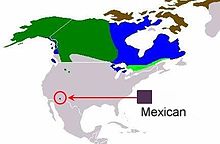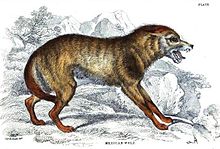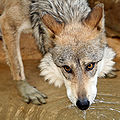- Mexican Wolf
-
Mexican Wolf
Spanish: Lobo Mexicano
Nahuatl: Cuetlāchcoyōtl
Captive Mexican Wolf at Sevilleta National Wildlife Refuge, New Mexico Scientific classification Kingdom: Animalia Phylum: Chordata Class: Mammalia Order: Carnivora Family: Canidae Genus: Canis Species: C. lupus Subspecies: C. l. baileyi Trinomial name Canis lupus baileyi
(Nelson & Goldman, 1929)Mexican Wolf range The Mexican Wolf (Canis lupus baileyi) is a subspecies of the Gray Wolf. It is native to North America, where it is the rarest and most genetically distinct subspecies.
Contents
Physical features
The Mexican Wolf is the smallest Gray Wolf subspecies present in North America. Reaching an overall length no greater than 1.2–1.5 metres (3.9–4.9 ft) and a maximum height of about 80 centimetres (31 in), it is around the size of a German Shepherd. Weight ranges from 27–37 kilograms (60–82 lb). In stature, it resembles some European wolves, though its head is usually broader, its neck thicker, its ears longer and its tail shorter.[1]
History
The Mexican Wolf was described by both naturalists Hernández and Fernandez.[1]
Former range and extirpation
Until recent times, the Mexican Wolf ranged the Sonoran and Chihuahuan Deserts from central Mexico to western Texas, southern New Mexico, and central Arizona. By the turn of the 20th century, reduction of natural prey like deer and elk caused many wolves to begin attacking domestic livestock, which led to intensive efforts by government agencies and individuals to eradicate the Mexican Wolf. Hunters also hunted down the wolf because it killed deer. Trappers and private trappers have also helped in the eradication of the Mexican Wolf. (Note that recent studies completed by genetics experts show evidence of Mexican Wolves ranging as far north as Colorado). These efforts were very successful, and by the 1950s, the Mexican Wolf had been eliminated from the wild. In 1976, the Mexican Wolf was declared an endangered subspecies and has remained so ever since. Today, an estimated 340 Mexican Wolves survive in 49 facilities at the United States and Mexico.[2]
Reintroduction to the Southwest
In 1997, controversy arose when a captive pack at Carlsbad Caverns National Park designated for release was found by Roy McBride, who had captured many wolves for the recovery program in the 1970s, to be largely composed of wolf-dog hybrids. Though staff initially argued that the animals' odd appearance was due to captivity and diet, it was later decided to euthanise them.[3]
In March 1998, the United States Fish and Wildlife Service (USFWS) began reintroducing Mexican Wolves into the Blue Range area of Arizona. The overall objective of this program was to reestablish 100 Mexican Wolves in the Apache and Gila National Forests of Arizona and New Mexico by 2008.
On March 30, 1998, government biologists released 11 gray wolves – 3 adult males, 3 adult females, 3 female pups and yearlings and 2 male pups — from 3 chain-link acclimation pens within the 18,130 square kilometres (7,000 sq mi), federally designated Blue Range Wolf Recovery Area in east-central Arizona.
A population count completed by the Interagency Field Team (IFT) in the winter of 2006–2007 estimated 60 wolves living in the recovery area in several packs.[4]
In February 2010, three captive Mexican Wolves living in the Wildlife Science Center in Forest Lake, Minnesota escaped from their pen after it was pried open by unknown individuals. Two of the wolves came back on their own the next day; the third wolf, the alpha of the pack, had to be chased down in suburban areas until captured.[5]
Captive breeding programs
There are 47 Mexican Wolf breeding facilities in United States and Mexico with the largest in the world being the Wild Canid Survival and Research Center near Eureka, Missouri which was founded in 1971 by naturalist Marlin Perkins.[6] Another captive breeding center that was founded in 1977 is the California Wolf Center located in Julian, California. The Center is the third largest breeding and host facility for Mexican gray wolves in the United States.[7]
Gallery
-
A captive, resting Mexican Wolf at the Minnesota Zoo
-
A captive Mexican Wolf running in its zoo enclosure at the Smithsonian National Zoological Park
-
At the Arizona-Sonora Desert Museum
See also
- California Wolf Center
- Wild Canid Survival and Research Center
Notes
- ^ a b The Natural History of Dogs: Canidæ Or Genus Canis of Authors. Including Also the Genera Hyæna and Proteles by Charles Hamilton Smith, contributor William Home Lizars, Samuel Highley, W. Curry, Junr. & Co, Published by W.H. Lizars, ... S. Highley, ... London; and W. Curry, jun. and Co. Dublin., 1839
- ^ USFWS Species Survival Plan Captive Facilities
- ^ Letter from Roy McBride to David Parsons
- ^ USFWS Wolf Recovery in North America(2007)
- ^ Dunbar, Elizabeth (18 February 2010). "Missing Mexican wolf found in New Brighton". MPR News. http://minnesota.publicradio.org/display/web/2010/02/18/missing-wolf/. Retrieved 15 November 2010.
- ^ Carbery, Kevin (17 April 2008). "Wolves welcome in Jefferson County". St Louis Today – Suburban Journal. http://suburbanjournals.stltoday.com/articles/2008/04/17/news/doc4805e900b5b95941198296.txt. Retrieved 15 November 2010.
- ^ "Lost Lobos: Local Wolf Experts Voice Dismay Over Killing of 3 Rare Mexican Wolves". East County Magazine. 2010-07-21. http://eastcountymagazine.org/node/3838. Retrieved 2010-07-30.
External links
- Mexicanwolves.org - completely dedicated to lobos, with essays, photos, video, interactive maps, and ways to get involved in Mexican wolf reintroduction.
- The Living Desert - a zoo and nature preserve that coordinates Mexican Wolf reintroduction efforts
- California Wolf Center - a wildlife education center dedicated to the restoration of North American Ecosystems. The Wolf Center is a major participant in Mexican Wolf Recovery Efforts single purpose private fund dedicated to assisting with livestock conflicts involving the Mexican Wolf Recovery program.
- Field Trip Earth - Field Trip Earth is a conservation education website operated by the North Carolina Zoological Society.
Categories:- Wolves
- Megafauna of North America
- Mammals of Mexico
- Mammals of the United States
- Fauna of the Southwestern United States
Wikimedia Foundation. 2010.







